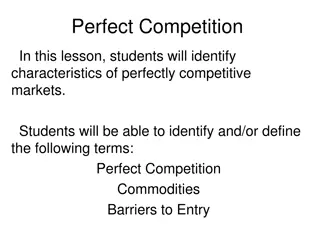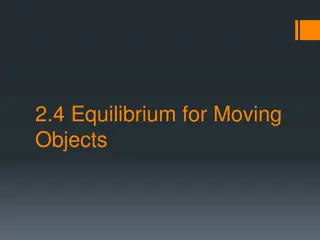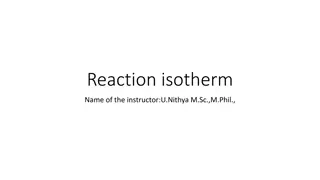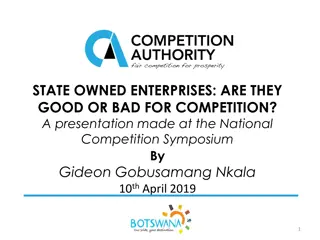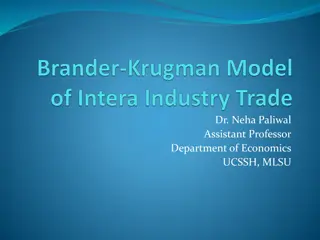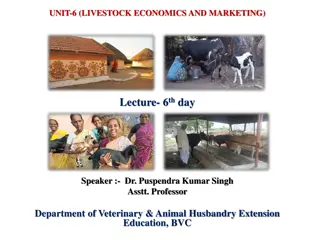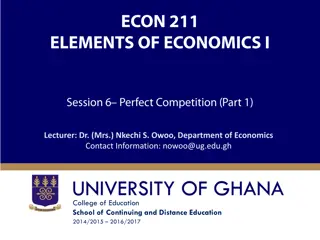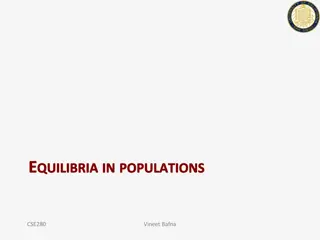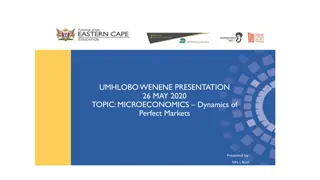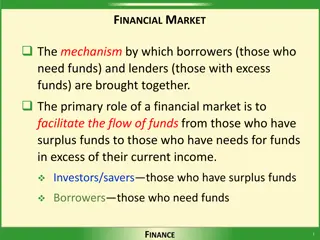Understanding Equilibrium in Perfect Competition Markets
Perfect competition in economics refers to a situation where numerous buyers and sellers are involved in trading identical goods freely, with full market knowledge and no government restrictions. Key characteristics include a large number of buyers and sellers, homogeneous products, free entry and exit of firms, and no price control. Equilibrium in the short run is analyzed based on total cost, total revenue, marginal cost, and marginal revenue. By achieving the point where marginal cost equals marginal revenue, firms can maximize profits in a perfect competition scenario.
Download Presentation

Please find below an Image/Link to download the presentation.
The content on the website is provided AS IS for your information and personal use only. It may not be sold, licensed, or shared on other websites without obtaining consent from the author. Download presentation by click this link. If you encounter any issues during the download, it is possible that the publisher has removed the file from their server.
E N D
Presentation Transcript
Equilibrium of the firm under: Perfect Competition According competitive market is a situation where large number of buyers and sellers are engaged in the purchase and sale of identically similar commodities, who are in close contact with one another and who buy and sell freely among themselves. to Boulding Perfectly
Characteristics of Perfect competition 1. Large Number of Buyers and Sellers 2. Existence of Homogeneous Product 3. Free Entry and Exit of Firms 4. Buyers and Sellers have full Knowledge of market 5. Mobility of Factors of Production 6. Non-Existence of Transport Costs 7. Non-existence of Government Restrictions 8. Non-existence of Price Control
Equilibrium of the firm under perfect competition (Short run) The Equilibrium of the firm can be discussed in terms of : Total cost and Total Revenue (TC/TR) Marginal Cost and Marginal Revenue (MC/MR)
Short-Run Cost curves Total Cost = Total Fixed Cost + Total Variable Cost Total Fixed Cost (TFC) is graphically denoted by a straight line parallel to X-axis showing output. Total Fixed Cost Curve Total variable cost curve The Total Variable Cost Curve as shown in Figure has broadly an inverse 'S' shape. This reflects the law of variable proportions.
. TC, TVC and TFC Total Cost Curve
Equilibrium of a firm under Perfect Competition through TC & TR
Equilibrium of a firm under perfect competition through MC & MR To maximize profits, a firm should produce and sell up to the point at which the MR=MC Beyond the point of equality of marginal cost and marginal revenue the firm will experience losses Thus, the main condition of firm's equilibrium is that the firm should stop at the point of equality of marginal cost and marginal revenue.
Equilibrium of a firm under perfect competition through MC & MR The marginal cost curve is given as a dotted line. Point A shows the equality of marginal cost revenue. OQ is the maximum quantity which the firm can produce as this is the profit-maximising quantity. Output beyond this, say at 8 units or OR , which mean losses to the firm, the marginal revenue for this output is RB but marginal cost is higher at RC . Therefore, if the firm produces OR , it will incur a loss indicated by the triangle ABC and marginal Output
Equilibrium of a firm under perfect competition through MC & MR The first and essential condition of equilibrium of a firm is the equality of MR and MC. It is necessary that beyond the point of equilibrium, MC must be higher than MR If MC is lower than MR beyond the point of equilibrium, the firm will like to produce more so as to secure profits The MC curve should cut MR curve from below as shown in figure Output
Equilibrium of a firm under perfect competition through MC & MR The MC curve cuts the MR curve at two places. At point A it cuts from above and at point B from below. Therefore, there are two points of equilibrium A and B Before point A MC is higher than MR which means loss. So, point A cannot be a determinate equilibrium point Beyond point A the MC is lower than MR and the firm can go on producing till it reaches OR amount. The determinate equilibrium therefore, OR or B for beyond that point marginal cost is higher than marginal revenue. We can conclude, therefore, that the equality of MC and MR is not a sufficient condition of firm's equilibrium and that it is necessary for the MC curve to cut the MR curve from below for determinate equilibrium point is, Output
Different Cost Conditions: Equilibrium of the Firm under perfect competition in short run The short run equilibrium of firms when they are working under different cost conditions Difference in the quality of raw materials used by the various firms, Differences in production techniques, Differences in efficiency of managers employed by them, Differences in the size of plants built by them and Differences in the ability of the entrepreneurs themselves account for the differences in costs of the various firms
For all the firms, Marginal Revenue (price) equals the Marginal Cost at equilibrium output. Firm B Firm A Firm C In firm A where, MR=MR Production 100 In firm B where, MR=MR Production 500 In firm C where, MR=MR Production 1000
. Firm C Firm A Firm B Normal profit Supernormal profit AC is always less than MR & MC Losses AC is always more than MR & MC MR=MC=AC
Long Run Equilibrium under Perfect Competition Short Run Long Run ------- Price= The price and quantity combination corresponding to the equilibrium point P shows the actual magnitudes as determined by the market. No other combination of price and quantity of the commodity at which the willingness or intentions of buyers and sellers will be identical.





